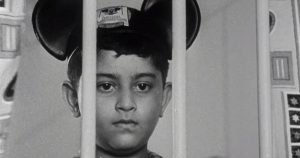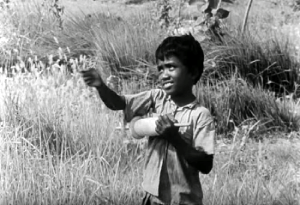A Satyajit Ray film is like an old wine that just gets better with the passage of time. If there’s one thing that someone can surely take away from his films, it’s the surprising universality that cuts through geographical boundaries and becomes relatable on a humanistic level. This is what constitutes the essence of Ray’s enchanting cinema. I encountered Ray’s short film Two for the first time about three years ago, and I was completely awestruck by its economical style of storytelling. Three years later, my reception of the movie remains the same. However, I have also come to realize that the film does not have one clear meaning, and that’s probably what the hallmark of a great piece of cinema is- to make you think.
This obscure gem, which was made sometime between the poetic Charulata and the psychologically rich Nayak, wasn’t available to the general public until the Academy Film Archive decided to restore its 16mm print as a part of its project focused on the restoration of Ray’s oeuvre. This project began shortly after Ray was conferred with an Academy Honorary Award. Two is a silent film, devoid of any spoken language. This move was deliberate on Ray’s part. Ray was asked by PBS (Public Broadcasting Service) to make a short film in a Bengali setting but in the English language. However, this didn’t appeal to Ray, and he decided to make a silent film, as a tribute to the golden era of silent cinema.
In a nutshell, one could say that the film is about what kids do when they are left alone, but that is of course, not the take I am interested in. It only takes a single viewing to understand what the film is essentially trying to convey. On the surface, it’s a typical parable of class struggle- the rich oppressing the poor. But my second viewing also made me realize that it has more to it than what it seems to offer on the surface. In short, it’s perfection tightly packed in 12 minutes.
As the very title of the film suggests, the film focuses on only two people – a kid living in a mansion and a kid living in a shanty dwelling. The two unnamed characters engage in a harmless competition throughout the film. It seems that for both the kids, the competition has two different meanings. For the rich kid, the game is about exemplifying his authority and satisfying his ego, while for the poor kid, the game is about survival. In the film, the rich kid, who represents a section of the society that’s above the poor strata, is literally above the poor kid, as he is above the ground. His position gives him a sense of authority, and confidence too. He flaunts his fancy toys throughout the course of the film and takes pride in competing with the poor kid, who unlike the rich kid, does not have equal access to opportunities. The rich kid continues to “fight” or “oppress” the poor kid, but it doesn’t dampen the spirit of the latter who continues his struggle, even after his kite gets shot down by the former.

At last, the deuce between the two players reaches a conclusion when the rich kid gives in to the obstinacy of the poor kid, and the closing shot of the film frames him in an isolated, crestfallen state, possibly reflecting on his actions. The chilling factor to the closing shot comes when the poor kid continues to play the flute, thus showcasing his emotional resilience and the will to carry on against all odds. The music of the film, including the hauntingly beautiful tune of the flute, was composed by Ray, and it just goes on to show his mastery over other forms of art besides filmmaking.
The film has been interestingly viewed by many as an anti-war film. This is probably because the film was made at the time of the Vietnam War, which had managed to capture the whole world’s attention, and had moved Ray too. Through this film, it seems that Ray attempts to give a miniature representation of the actions of the geopolitical chessboard. The rich kid probably represents America’s hegemony, while the poor kid is the personification of Vietnam’s resistance. Though not as convincing as the Vietnam angle, one can also consider the film as an allegorical take on another America-related story. Before the Vietnam War, America committed a heinous crime by dropping nuclear bombs on the Japanese cities of Hiroshima and Nagasaki in retaliation of the attacks on Pearl Harbour, and Japan is still struggling with the long-term consequences of that action (birth defects and physical deformities for instance). However, Japan emerged stronger than ever before and made rapid developments in terms of technology and infrastructure.
Another comparison of the film that I can think of is with India’s freedom struggle and British imperialism. British Raj did whatever it could to oppress Indians and even resort to violence to break their backbone (the shooting down of the kite by the rich kid is an interesting comparison to that), but just like the poor kid who attempts to pick himself up after his kite gets shot down, Indians too continued their struggle even after being subject to subjugation and emerged victorious at the end.

Like many Ray films, this film is also replete with close-up shots that bring the emotions of the characters to the limelight. One can experience a myriad of emotions while watching the film, which I did too. Initially, I was enamored of the apparent innocence of the rich kid, then I got enraged with his efforts to oppress the poor kid, and then finally, I was engulfed with pity for the rich kid, who gets humiliated in his own eyes for trying to suppress the restless spirit of the poor kid. Despite having fancy possessions, the rich kid does not feel content and instead feels like a prisoner, trapped behind the bars of the window overlooking the slums, where the poor kid resides without fancy toys and Coca-Cola but finds joy in flying kite in the open.
An interesting detail that I noticed while watching the film that may sound far-fetched, but is still worth mentioning, is that right before shooting down the kite, the rich kid takes an apple out of the refrigerator and eats it. In Biblical folklore, the apple is often interpreted as the symbol of sin and the fall of man, and therefore, in my opinion, the apple scene is quite apt as it symbolizes the rich kid’s ego and his temptation for materialistic possessions.
